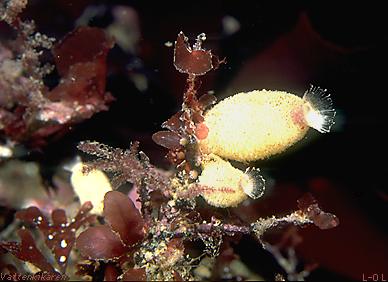 |
|
Inner and outer fishing apparatus
Certain suspension feeders, e.g. plumose
anemone , hydroids
and the polychaete Pomatoceros
triqueter do nothing more than hold up their tentacles in the water
currents. When the water currents are very weak, suspension feeders run
the risk of getting too little food, but there are suspension feeders that
are able to create currents to increase the amount of food, for example
barnacles.
To enable mobility and to be able to catch very small particles
of food, the tentacles have to be very light and finely constructed, but
this also makes them brittle and sensitive to wave action and attacks from
predators. Therefore, many creatures suck water into their bodies where
the tentacles are well protected. This is the case with the bread
crumb sponge, blue
mussel and the sea
squirt.

| The yellow sponge in the picture above is of the
Scypha family . Water is pumped through the body and
edible particles are caught. The largest sponge is about 7 cm long.
|
 |
Page
9 of 52 |
 |
|



